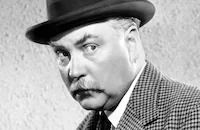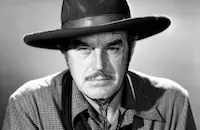Sherlock Holmes and the Secret Weapon

Brief Synopsis
Cast & Crew
Roy William Neill
Basil Rathbone
Nigel Bruce
Lionel Atwill
Kaaren Verne
William Post Jr.
Film Details
Technical Specs

Synopsis
Disguised as an old bookseller, private detective Sherlock Holmes pretends to be a Nazi spy in order to help Swiss scientist Dr. Franz Tobel escape from a Gestapo trap in Zurich. Holmes and Franz take a British transport plane to London, where the physicist leaves the safety of Holmes's Baker Street address for a secret meeting with his wife, Charlotte Eberli Tobel. Franz gives her an envelope containing a coded message, and asks Charlotte to give it to Holmes should anything happen to him. Having been unknowingly tailed to Charlotte's apartment by German spies, Franz is saved from abduction when a London bobby happens by. The next day, Franz successfully demonstrates his new bombsight for Sir Reginald Bailey and the British air ministry. Back at Whitehall, Franz tells Sir Reginald that, while he is willing to allow the British to use his invention, only he will know its secret. Franz then splits his invention into four parts and hires four Swiss scientists living in London to construct separately each part. Soon after, Holmes receives a call from Scotland Yard's Inspector Lestrade telling him that Franz has disappeared. Holmes and his physician assistant, Dr. John H. Watson, go to Charlotte's apartment, where the young lady gives the detective Franz's envelope. Rather than the physicist's coded message, the message inside is from Holmes' nemesis, master criminal Professor Moriarty. Holmes then goes into the Soho district, disguised as Ram Singh, one of Moriarty's old henchmen. Led to the criminal by Moriarty's own henchmen, Peg Leg and Jack Brady, Holmes pleads with Moriarty to release Franz for the good of England, but Moriarty refuses and gloats over his victory over his longtime foe. Holmes is forced into the false bottom of an old sea chest, but is rescued from a watery grave when Watson and Lestrade discover Brady and Peg Leg struggling with the chest. Holmes then rushes back to Charlotte's apartment, where he discovers the tracings of Franz's coded message on a notepad. With Watson's help, Holmes breaks the first three lines of the code, which are the names and addresses of three Swiss scientists, but soon learns that all three men have been murdered. Meanwhile, Moriarty, unable to break the fourth coded line, tortures Franz for the name of the fourth scientist. Back on Baker Street, Holmes breaks the fourth line's code and rushes to the home of Professor Frederick Hoffner. At the same time, Moriarty deciphers the code, but rather than sending his Nazi assistants to kill Hoffner, Moriarty decides to abduct the elderly Swiss scientist, as insurance should Franz fail to recover from the torture. The German agents, however, bring a disguised Holmes to Moriarty's hideout. Taking Holmes's own suggestion, Moriarty straps Holmes to an operating table and slowly starts to bleed the detective to death. Holmes is saved at the last minute, however, by Watson and Lestrade, who have followed a trail of fluorescent paint droppings to the criminal's waterfront hideout. The spies are captured, and when Moriarty attempts to make his escape through a secret passageway, he falls, seemingly, to his death, as Holmes had previously discovered the criminal's hidden trap door. With Franz and his bombsight safely in English hands, Holmes and Watson watch as a squadron of British planes head for Germany.

Director
Roy William Neill
Cast

Basil Rathbone

Nigel Bruce

Lionel Atwill

Kaaren Verne
William Post Jr.
Dennis Hoey

Holmes Herbert
Mary Gordon

Harry Woods
George Burr Macannan
Henry Victor
Harold De Becker

Paul Fix
Davis Roberts

Harry Cording
Paul Bryar
Vicki Campbell
Gerard Cavin
Guy Kingsford
George Eldredge
John Burton
Leyland Hodgson
Leslie Denison
James Craven
Crew
Howard Benedict
Bernard B. Brown
W. Scott Darling
W. Scott Darling
R. A. Gausman
Edmund L. Hartmann
Edward T. Lowe
Edward T. Lowe
Otto Ludwig
Tom Mcknight
Paul Neal
Martin Obzina
Jack Otterson
Charles Previn
Edward R. Robinson
Frank Skinner
William Tummel
Vera West
Les White

Film Details
Technical Specs

Articles
Sherlock Holmes and the Secret Weapon
However, Universal passed on presenting Holmes in a Victorian-era context as did the Fox features. Opting instead to stir patriotic fervor on both sides of the Atlantic, the great detective was shifted to a contemporary context, where his deductive prowess could be pitted against the Axis war machine. The second Holmes film made under Universal's aegis, Sherlock Holmes and the Secret Weapon (1942), shows the most familiar elements of the studio's formula for the series, from the performances of the leads to the flag-waving motifs, to their best effect.
Ostensibly based on Conan Doyle's The Dancing Men, the screenplay incorporated no more than the adventure's stick-figure code in presenting a tidy tale of international intrigue. In the guise of an old bookseller, Holmes penetrates the Swiss border for the purposes of providing safe passage abroad to the brilliant young inventor Dr. Franz Tobel (William Post, Jr.). Tobel has devised a bombsight of such unparalleled accuracy as to determine the outcome of the European air war, and those ramifications were not lost on the principled scientist. Adamant that production of the weapon be under his control, Tobel constructed his prototype in four discrete modules, each capable of replication and each useless by itself.
Tobel delivers each section to a British craftsman that he deems trustworthy, and whose identities will be his secret. Unfortunately, the Nazis have made it worth the while of Professor Moriarty (Lionel Atwill) to betray his country and ferret out the weapon smiths possessing the crucial components. From there, Holmes must win a deadly race to keep the bombsight from being delivered to the Luftwaffe.
There are various trademark aspects of the Universal Holmes series that made their bow in Sherlock Holmes and the Secret Weapon. It was the first installment directed by Roy William Neill, who would go on to helm the 10 sequels that followed over the next four years. "Neill and his crew of writers and technicians seem to wrest as much well-constructed story and production value from their Holmes stories as could be seen in much bigger budgeted films," Ron Haydock observed in Deerstalker! Holmes and Watson on Screen (Scarecrow Press). The film also cast Dennis Hoey in his first appearance as Inspector Lestrade, the blustering cop who's always a few steps behind Holmes' case-breaking discoveries.
The venerable screen villain Atwill is much more than serviceable as Moriarty, deliciously evil in his execution of the denouement's death trap. Cornered with reinforcements still moments away, Holmes seeks to buy time by taunting his nemesis's intentions to do away with him by so pedestrian a means as gunfire. The Professor buys into Holmes' suggestion of gradual bloodletting as the most sadistic means of murder. It's fairly astonishing that Atwill's reference to Holmes' drug usage -- "The needle to the last, eh, Holmes?"--made its way past the censors; in the novels it was merely one aspect of Holmes' often enigmatic personality.
Best of all, of course, are the efforts of the two leads that kept the film and the very series afloat. Rathbone's handle on the character--cunning, imperious, implacable, preternaturally observant--led to a connection with the role that the versatile performer came to regret, and he would never recover the career heights he knew after he determinedly walked away from 221 B Baker Street in 1946. Bruce's semi-comic take on Watson would never endear him to Conan Doyle purists, but his palpable chemistry with his old friend Rathbone appealed to the moviegoing public.
As Rathbone declared in his autobiography In and Out of Character, "[T]here is no question in my mind that Nigel Bruce was the ideal Dr. Watson, not only of his time but possibly of and for all time...It has always seemed to me to be more than possible that our 'adventures' might have met with a less kindly public acceptance had they been recorded by a less lovable companion to Holmes than was Nigel's Dr. Watson, and a less engaging friend to me than was 'Willy' Bruce."
Producer: Howard Benedict
Director: Roy William Neill
Screenplay: W. Scott Darling, Edmund L. Hartmann, Edward T. Lowe, Jr., Arthur Conan Doyle (story)
Cinematography: Lester White
Film Editing: Otto Ludwig
Art Direction: Jack Otterson
Music: Frank Skinner
Cast: Basil Rathbone (Sherlock Holmes), Nigel Bruce (Dr. John H. Watson), Kaaren Verne (Charlotte Eberli), Lionel Atwill (Prof. Moriarty), William Post, Jr. (Dr. Franz Tobel), Dennis Hoey (Inspector Lestrade).
BW-68m.
by Jay S. Steinberg

Sherlock Holmes and the Secret Weapon
Quotes
Brilliant man, Sherlock Holmes, too bad he was honest.- Prof Moriarty
The needle to the last, eh, Holmes?- Professor Moriarty
... I must confess I shied at the thought of disemboweling a complete set of Charles Dickens.- Sherlock Holmes
Trivia
Notes
The working title of this film was Sherlock Holmes Fights Back. The Sir Arthur Conan Doyle short story from which this film is based was first published in the United States in Collier's (5 December 1903) and is included in the collection The Return of Sherlock Holmes (London, 1905). This was the second film in the Universal "Sherlock Holmes" series, and the first to be directed by Roy William Neill, who went on to direct all subsequent Sherlock Holmes films at Universal. Dennis Hoey made his first appearance as "Inspector Lestrade," who became a recurring character in the Universal Holmes series. Later in 1943, character actor Robert O. Davis changed his stage name to Rudolph Anders, a variation on his character's name in this film.
Modern sources include Michael Mark (George) and Philip Van Zandt in the cast. Some modern sources also claim that noted character actor Henry Daniell played a bit part in the film, but he was not seen in the viewed print and it is doubtful that he actually appeared. For additional information on the series and other films featuring the Arthur Conan Doyle characters, consult the Series Index and see the entry below for Sherlock Holmes and the Voice of Terror, and the entries for Sherlock Holmes and The Hounds of the Baskervilles in the AFI Catalog of Feature Films, 1931-40; F3.4020 and F3.2009.















